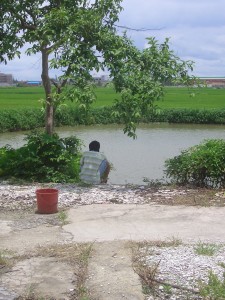 I just finished reading Malcolm Gladwell’s Outliers and came across a passage that struck me.
I just finished reading Malcolm Gladwell’s Outliers and came across a passage that struck me.
His theory is that the cultures that cultivated rice paddies, as compared to other crops such as wheat, learned that their success depended not on the whims of weather or the will of god, but on hard work; and that the complex, involved and constantly demanding all-year-long task of rice cultivation lead to a culture of hard work that leads to academic success and has been mistaken for high IQs.
Well, that’s my summary anyways.
As a footnote that supports his argument, he included reference to a paper by James Flynn who said that the majority of Chinese immigrants to the West were from the Pearl River Delta, which looks on the map to be about half of the province of Guangdong (or Canton as my family knew it), the middle half, and whose descendants were often at the top of their class at MIT.
 Bolstering the theory of rice cultivation = hard work and smarts, he said the lowest-achieving Chinese-Americans were the Sze Yap people, who ‘come from the edges of the Delta, “where soil was less fertile and agriculture less intense”.
Bolstering the theory of rice cultivation = hard work and smarts, he said the lowest-achieving Chinese-Americans were the Sze Yap people, who ‘come from the edges of the Delta, “where soil was less fertile and agriculture less intense”.
Since my background is Sze Yap, I thought I’d look into this. As far back as I know, granddad’s family had a shoe factory, and sent him to Canada to work as a houseboy when his age was a single digit. He also sold fish on street corners, so was evidently rather hard-working. He returned to China and then immigrated back to Canada where he opened a produce store, and was a successful businessman. I’ll have to see if we know of any rice-growers in the paternal family (Mom’s great-granddad came to Hawaii to plant rice which, I suppose, means we should be harder working than we are…)
An article by Flynn can be found here, which is an excerpt from a longer book. The chapter only mentions the disproportionate number of Asian-Americans in the MIT entrance class, but it sounds like the stats on achievements may be in the full book. He credits his anecdote on my underachieving ancestors from:
Lee, R. H. (1960). The Chinese in the United States of America. Hong Kong:University Press.
The contents don’t actually divide the Chinese up into categories, and don’t specifically mentioning anything about the Cantonese or those from the Pearl River Delta.
 A review of the book from 1961 describes Rose Hum Lee as “a professional sociologist” and the book is one “in which what she feels about America as an American-born Chinese and what she assumes to be the proper roles of the Chinese in America obscure her perception of the reality she is supposed to describe” (Maurice Freeman). Ouch.
A review of the book from 1961 describes Rose Hum Lee as “a professional sociologist” and the book is one “in which what she feels about America as an American-born Chinese and what she assumes to be the proper roles of the Chinese in America obscure her perception of the reality she is supposed to describe” (Maurice Freeman). Ouch.
An academic pal found a biography of her online. Born in 1904 in Montana, she apparently used her family often as examples in her sociological work, but made them anonymous under the fiction that her work was ‘detached’.
Knowing what little I know about Sze Yap and combined with what was said about her book, it’s fair to assume that her assertion is not based on any statistics. To compare Sze Yap descendants to another group, she would have had get a reliable sample size of stats on the Cantonese, find out which villages they came from, and then ascertain that those from the small Sze Yap area of the Delta were lower achieving. And then, lower achieving by what measure? And would the comparison be to an average of all other Chinese, Cantonese, or to other districts of Canton? If any comparison could be made, it would have been between those from Sze Yap (the four districts) and those from Sam Yap (the three districts), as these were the two neighbouring regions in Canton where most of the early Chinese immigrants came from and then settled all over the world, from North America to South America and Europe and Australia.
I found another mention of Sze Yap as “a district in south China that was more commercially sophisticated than many other parts of the country, with a history of contacts with foreign traders”. But, according to Gladwell’s thesis, wouldn’t commercial activities and trade, with people from another culture and language, be as stimulating, complex and demanding as rice cultivation?
It probably sounds like I’m trying to defend my family honour, but I’d rather believe it’s more a statement on the way Gladwell puts his arguments together, and the way non-fact and opinion can work their way into our thinking as facts.
Rose Hum Lee likely made a personal observation about the Sze Yap people. This was used in an argument many years later by Flynn, and then taken from there by Gladwell. The original statement and thesis may not be true at all, but this factoid is stated so plainly that it could be taken as truth, and the popularity of Gladwell’s writing means that untruth gets widely spread.

(photos are from a family trip to the ancestral village, in Kai Ping in Sze Yap, 2005)
